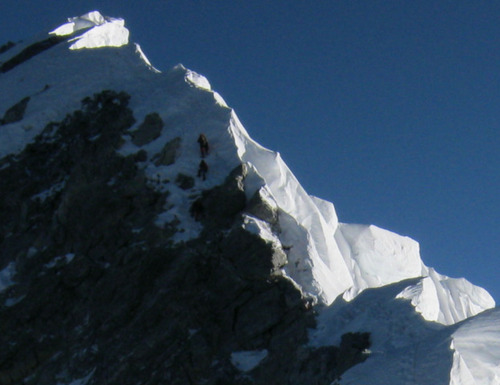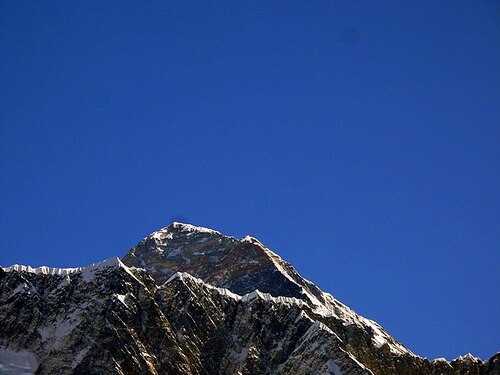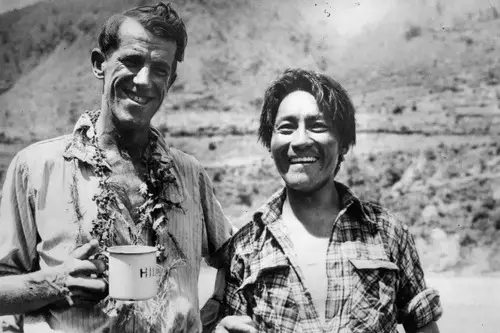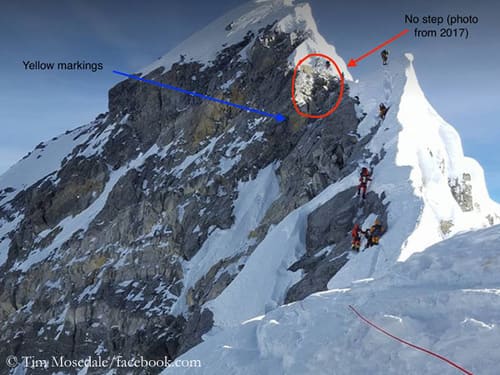The Hillary Step got its name from Sir Edmund Hillary and is located between the South Summit and the real summit of Mount Everest. Located on the southeastern side of the mountain, it marks the final significant challenge along the South Col route prior to reaching the summit. However, it’s also renowned in geological spheres.
The Hillary Step is, or was, made up of a tough layer of limestone situated at the bottom of the Qomolangma Formation. The limestone originates from the Upper Cambrian or Lower Ordovician era. These rocks contain small traces of crinoid ossicles, which are parts of sea lilies that existed in a shallow tropical ocean around 450 million years ago. Surprisingly, these remnants can now be discovered at the peak of Everest.
What is the Hillary Step?

The Hillary Step, a precipitous rock facade is of approximately 12 meters (40 feet) in height. It was situated in close proximity to the summit of Mount Everest, at an elevation of roughly 8,790 meters (28,839 feet). Nestled along the southeastern ridge, the Hillary Step was positioned midway between the “South Summit” and the true pinnacle. This rocky feature posed the most technical challenge in the ascent of Everest from the Nepal side. It constituted the ultimate trial that climbers had to face before conquering the summit. However, the rock was destroyed by an earthquake that struck Nepal in 2015.
Ascending the Hillary Step posed a threat, with a dangerous descent of 3,000 meters (10,000 feet) on the right side (when ascending) and a drop of 2,400 meters (8,000 feet) on the left. Scaling this portion unassisted, classified as a Class 4 rock climb, taking place within the harrowing expanse known as the death zone. An expedition noted the strenuous nature of this ascent, albeit offering a degree of shelter from the elements.
During certain climbing seasons, particularly following substantial snowfall, it was possible to bypass the rock face through snow and ice climbing. Known for its dangerous and technical terrain, the step had claimed many lives. In 1996, Anatoli Boukreev recounted discovering a suspended body attached to ropes at the base of the step, as detailed in his book “The Climb.”
Climbing the Challenging Hillary Step

In 1953, the first group attempting to climb reached the South Summit of Everest on May 26th at 1:00 PM. Tom Bourdillon and Charles Evans were part of this group, but they arrived too late to try reaching the very top of the mountain. They sat on the snowy area and could clearly see the last 90 meters (300 feet) they needed to climb to get to the summit. However, it wasn’t the smooth snowy path they had expected. Instead, it was a narrow strip of snow and ice on top of rock. The left side was steep, and the right side had a part that hung over like a shelf of snow.
About two-thirds of the way up this difficult path, there was a large, imposing rock step that was 12 meters (40 feet) high. This rock step caught their attention because it looked quite challenging.
The Hillary Step got its name from Sir Edmund Hillary. He was the first person, along with Tenzing Norgay, to successfully climb it while on their way to the summit during the 1953 British Mount Everest Expedition. On May 29th, 1953, Hillary and Tenzing managed to climb the Hillary Step by using a crack between the snow and the rock. Hillary noted that the snow on this step was harder than the snow they encountered at lower parts of the mountain. In 1953, Hillary wrote:
“After an hour’s steady going we reached the foot of the most formidable-looking problem on the ridge – a rock step some forty feet [12 m] high. We had known of the existence of this step from aerial photographs, and had also seen it through our binoculars from Thyangboche. We realized that at this altitude it might well spell the difference between success and failure. The rock itself, smooth and almost holdless, might have been an interesting Sunday afternoon problem for a group of expert rock climbers in the Lake District, but here it was a barrier beyond our feeble strength to overcome.
I could not see a way to turn it on the steep rock bluff to the west, but fortunately, another way of approaching it still existed. On its east side was another great cornice, and running up the full forty feet [12 m] of the step was a narrow crack between the cornice and the rock. Leaving Tenzing to provide the best possible belay, I inserted myself forcefully into the crack. Subsequently, I used my crampons to kick backward, driving their spikes deep into the frozen snow behind me, and effectively lifted myself off the ground.
Utilizing every available rock hold and channeling the strength of my knees, shoulders, and arms, I executed a backward crampon ascent along the crack. During this process, I fervently hoped that the cornice would remain firmly attached to the rock. Despite the significant exertion, I maintained a slow yet steady progress. As Tenzing paid out the rope, I made incremental advancements until I could finally extend my reach over the top of the rock. Subsequently, I hauled myself out of the crack and onto a broad ledge. After a brief pause to catch my breath, a powerful determination surged within me, and for the first time, I truly believed that nothing could hinder our ascent to the summit. I took a firm stand on the ledge and signalled to Tenzing to come on up. As I heaved hard on the rope Tenzing wriggled his way up the crack and finally collapsed exhausted at the top like a giant fish when it has just been hauled from the sea after a terrific struggle.”
– Sir Edmund Hillary
Tenzing didn’t like the comparison of being pulled up like a fish, and this comparison was removed from later stories.
Evolution of Climbing Methods and Challenges on Mount Everest

In recent times, individuals ascending and descending the Step typically employed pre-installed ropes. The initial team of climbers often positioned these ropes at the beginning of the season. When climbing conditions were favorable, the journey from the South Summit to the Hillary Step would consume approximately two hours. After that, it would require another one to two hours to ascend the cliff. Finally, it would take about 20 minutes to reach the summit of Everest from the Hillary Step. Only one climber could go across it at a time. As more and more people climbed the mountain, the Step often became a bottleneck where climbers had to wait their turn on the ropes.
Before 2015, the order for coming down along the southeast ridge of Everest was:
- Summit of Everest
- Last slope leading to the top
- Hillary Step: A 12-meter (40 ft) high rocky cliff
- Traverse along a snowy ridge that hangs over (cornice)
- South Summit of Everest
- The Balcony at 8,400 meters (27,500 ft)
Does The Hillary Step Still Exist?
Yes, but after the April 2015 earthquake in Nepal, it might have changed the Hillary Step. In 2016, people began suspecting changes to the Step due to heavy snow, making it difficult to confirm. Kenton Cool said that the Hillary Step was only about 12 to 15 feet tall. In May 2017, Tim Mosedale and other climbers said that the Hillary Step was not there anymore. But they weren’t completely sure about how much it had changed.
Another climber, David Liaño Gonzalez, who had been to the top of Everest six times, thought the Step had changed by 2016. He had reached the summit in 2013 and 2016 when people say the changes happened. But some important climbers from Nepal, like Ang Tshering Sherpa, who was in charge of the Nepal Mountaineering Association, said that the Step was still there. It was just covered in more snow than before. Later that year, after looking at many pictures from 2006 to 2016, he did agree that at least the top part of the Step had really changed.
Speculation on the Hillary Step

Edmund Hillary’s son, Peter Hillary, was requested to share his opinion about the Hillary Step. He said that part of it was still there, but he felt like it had changed a bit. He noticed something that seemed like a new broken rock, which caught his attention. By the start of June 2017, more stories and pictures were coming in. Garrett Madison said that the step had definitely changed.
Dave Hahn, who had climbed Everest 15 times, saw the pictures too and agreed that it was different now. People in the climbing community felt a kind of sadness when they saw that some rocks were missing and new marks on the rock were there. This special place had changed. Hahn mentioned that this change was a way to honor Hillary and Tenzing, and whenever he climbed over it, he thought about them.
In 2017, a mountaineering guide named Lhakpa Rangdu organized a display of photos at the Nepal Tourism Board. These pictures were meant to show how the Hillary Step had become different. Rangdu had climbed Everest many times since 2005, both before and after the big earthquake in Nepal. He is also skilled in photography. With his ability to capture images in high-altitude locations and his experience in climbing, he was able to demonstrate the changes to the Hillary Step through photographs. He said that the Step is no longer there.
Is Everest Easier Without The Hillary Step?
Yes, Everest is easier without the Hillary Step. For those ascending the snow slope, the journey becomes smoother and less demanding, especially for beginners as the level of “climbing” required diminishes, providing a more manageable experience. Nevertheless, this route tends to narrow down and slow down the movement. The Hillary Step frequently caused a bottleneck situation; nevertheless, the situation was resolved by installing separate ropes for climbers ascending and descending.
